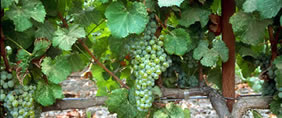|
 |
|||||||
|
|
|||||||
|
The following is a glossary of wine terms: Acidity: Term used to indicate quality of
tartness, sourness, or sharpness to the taste, due to the presence of
agreeable fruit acids. Acid
is perceived on the sides of the tongue and most intently on the
salivary glands. White
wines often have a citrus or green apple flavor to acidity while red
wine are more redolent of sour berries. Aftertaste: The taste sensation remaining in
the mouth for a short period of time immediately after wine is
swallowed. Both the character and length of the aftertaste may
collectively be described as “finish”.
Wine can have textural, flavorful or both elements on the finish. Aperitif: French word meaning “to open”
which refers to wine and other drinks taken before meals to stimulate
the appetite. Appearance: This refers to clarity not color.
Wines should be free of cloudiness and suspended particles. Aroma: This refers to the fruity scent in
a young wine, not to be confused with “bouquet” which is a more
complex scent in mature wines. Astringency: The degree of astringency of a
wine depends primarily upon the amount of tannin it has absorbed from
the skins and seeds of the grapes. Moderate astringency is a desirable
quality in many red wines. Though
dryness refers to a lack of perceivable residual sugar in the wine,
guests will often describe a tannic wine as very dry.
Balance: Balance indicates harmony among
the principle constituents of wine. Body: The degree of concentration and
intensity in a wine is referred to as the body of the wine. Light bodied
wines tend to be low in alcohol, tannin, and extract. Big, heavy bodied
wines tend to be higher in alcohol and flavor profile. Sweet wines are
often very rich and unctuous in texture as a result of moderate alcohol
and high levels of residual sugar. Bouquet: Scent of mature wine, to be
distinguished from “aroma”, which is given off by young wines. The
scent originates from the fermentation and aging of wine and is best
noticed when swirling the wine in the glass. Brut: French term applied to Champagne
with little perceivable residual sugar. Brut is drier than Extra-dry.
Ultra Brut, Brut Nature, Brut Zero all refer to Champagnes with
no perceivable residual sugar. Color: Each wine has its own “right”
color. A wine should be judged against the color that is correct for
each wine type. Crust: Deposit of sediment by wine while
aging in the bottle. The deposit adheres to the inside of the bottle as
a crust. Decant: To pour wine gently from a large
container or from the bottle in which crust or sediment has deposited,
for the purpose of obtaining clear wine for serving. Demi-Sec / Semi-Dry: Used to describe a fairly sweet
sparking wine. Dry: Opposite of sweet, free of sugar.
A wine becomes dry when all sugar has been consumed by fermentation. Fruity: Having the fragrance and flavor of
the grape, sometimes used to designate tartness. Generic Wine: Wine type names (such as Burgundy,
Chablis, Chianti, Champagne) to denote that the wine is best described
by general type rather than by the major grape variety used in its
production. Generic wines are normally blends of several grape varieties
in which neither percentage nor the character of any on variety
dominates. Magnum: A large wine bottle with capacity
of two ordinary bottles Nose: The name given to perceived odor
of wine. It is composed of aroma, bouquet and fermentation volatiles. Nutty: Term denotes the characteristic
flavor of Sherry. Racking Decanting from one large vessel to
another, be it a 225 liter oak barrel or a 10K liter stainless steel
tank. This process allows
the wine to breathe and it also clarifies the wine from the sediment. Sec French word for “dry” Sour: Disagreeable acid from vinegar
acid. A sour wine is spoiled wine. Not to be confused with dry,
astringent, or tart. Table wine: Wine with an alcoholic content
below 14%, suitable for serving with meals at the table. Tart: Possessing agreeable acidity; in
wine, tartness reflects the content of agreeable fruit acids. Varietal: A wine that is named for the
principal grape variety from which it is made. In California, the law
requires that any varietally labeled wine must contain at least 75% of
the grape of which it is named. Vintage wine: Wine made from grapes that were
harvested in one given year. Regulations specify that a vintage wine
must contain at least 95% of its volume from grapes of the year
specified.
|
|||||||
| Home | Mission Statement | Services | Resources | Contact | Industry Links |
| © 2005 tableside hospitality consulting |
|
|